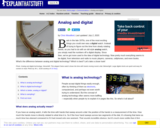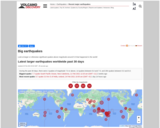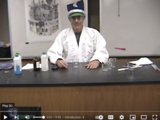
More information on analog and digital technologies.
- Subject:
- Science
- Material Type:
- Student Guide
- Provider Set:
- Utah SEEd Textbook Resources
- Author:
- ExplainThatStuff!
- Date Added:
- 02/25/2021

More information on analog and digital technologies.

Two opposing perspectives about analog versus digital from recording engineers.

The axolotl is a Mexican salamander with an incredible ability: Cut its leg off, and the limb will grow right back! How it does this and why humans can't is still a bit of a mystery. Researchers like Susan Bryant of UC Irvine are studying these amphibians to understand the underlying mechanisms for their miraculous regenerative powers.

Look at larger or otherwise significant quakes above magnitude around 5.5 that happened in the world!

In this video Paul Andersen will first define momentum as the product of an objects mass and velocity. He will then demonstrate how a net force acting on an object will change the momentum in the direction of the force. Several problems will be included.

Use this calculator to determine your exposure to radiation.

Use the calculator to estimate your yearly dose from the most significant sources of ionizing radiation.

Two clear liquids are mixed together and the audience is told to watch closely... "Don't take your eyes off the liquid or you'll miss it!" Then, in a flash, the water changes to ink (or so they think!). Clock reactions like this never fail to capture the students attention, and the Iodine Clock Reaction is one of the most startling chemical demonstrations you'll ever see. How did that happen? is almost always the reaction, and when students ask How?, theyre ready to learn.

Learn the basics of gas with this informative video. Gases are compressible, they diffuse and expand to occupy the volume of their container fully.

See how changing the concentration affects reaction rate by using this online tool

How to calculate the density of a gas.

A 25,000 mile line along the Pacific Rim, known as the "ring of fire," is the most geologically active place on earth. Harry Smith reports on why it's so dangerous and the damage it has done.

EcoForesters is a non-profit professional forestry organization dedicated to conserving and restoring our Appalachian forests through education and stewardship

The Ecoforestry Institute Society (EIS) is a registered non-profit, charitable society comprised of a volunteer Board and a strong core of community volunteers.

See how wind turbines generate clean electricity from the power of the wind. Highlighted are the various parts and mechanisms of a modern wind turbine.

Learn more about how the epigenome affects gene expression.

This is part one "Evidence of a Chemical Reaction." I conducted 4 demonstrations showing one or more of the following characteristics: a color change, precipitate formation, gas production, and a temperature change (either exothermic or endothermic). Part 2 of this video completes the aluminum foil and copper chloride demonstration and reviews the important concepts that were shared.

This is an example of Doppler shift using a car horn. This minivan was filmed going by at approximately 40-50 MPH. The frequency shift in the horn is quite evident as the car passes.

You are probably familiar with the characteristics and advantages of some of the common textile fibers. However, you may not understand the difference between all the various natural and manufactured (synthetic) fibers used in apparel and home furnishings.

The world's ocean are absorbing carbon dioxide at an unprecedented rate and the resulting acidification is transforming marine ecosystems. We look at how ocean acidification is already affecting coral reefs in the Florida Keys.